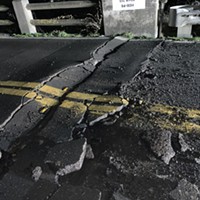[
{
"name": "Top Stories Video Pair",
"insertPoint": "7",
"component": "17087298",
"parentWrapperClass": "fdn-ads-inline-content-block",
"requiredCountToDisplay": "1"
}
]
The subject line for the e-mail said simply, "Cool Beans!" The message came from juice man Dave Feral (see "Table Talk," Oct. 4), who serves on the board for North Coast Grower's Association, the folks who run the local farmers' markets. Dave noted that he'd heard at a recent NCGA meeting that, "Paul Giuntoli of Warren Creek Farms has some of the best beans in the state," at least according to bean researcher Steve Temple from UC Davis.
Now, I've been looking at Paul's beans for some time. He displays them in boxes alongside his potatoes and other produce, and the beans certainly look cool — black ones, red ones, pale yellow ones and in particular the variegated black and white, or gold and white, or speckled red varieties. But I don't know enough about beans to tell which ones are the best, so I found Steve Temple's number, and left him a message before I headed to the newspaper office on unrelated business.
There I found Journal publisher Judy Hodgson finishing up her lunch, some sort of variation on cassoulet, a white bean dish. Without my remarking on her meal in any way, she announced that she'd found the best beans around, canario beans (akin to the Italian cannellini bean), from Warren Creek Farms.
Interesting.
Temple called later that day from the 24-acre UC Davis Bean Research Farm, where he was taking a break from the bean harvest. "We had bad rains and cold, wet weather for a couple of weeks and now we're trying desperately to get stuff out of the field," he explained.
You could call Temple a bean expert. He's been working with them for 33 years: 11 years at an international research center in South America, the rest at Davis, the "aggie" campus for the UC system, where his program is part of the UC Cooperative Extension.
What he's been doing is hybridizing heirloom bean strains, which, he emphasized, does not mean artificial genetic modification. "These are conventional breeding crosses, and then I work with the segregated populations to make selections, test them for diseases and insect resistance, things like that," he said. "From there we look at yield and cooking quality."
The bean strains Temple has been working on are deemed heirlooms since they are directly connected to the original beans bred by those who lived on this continent and in South America thousands of years ago. "They're improved in that they're now resistant to viruses, which makes them much better for organic, reduced input," Temple explained. "Small farmers, those who don't want to use pesticides, herbicides or fertilizers on their crop — they're friendlier for those growers, and for consumers who don't want beans grown with those kinds of things. Bottom line is they go back to very old parentage, but they're recent hybrids crossed with modern cultivars."
At this point he's focusing on five bean varieties that he's distributed to five different organic, direct-market farmers around California, one of them being Paul Giuntoli of Warren Creek Farms.
Temple and Giuntoli met about 12 years ago when the scientist spent a sabbatical year at Humboldt State. "He came to the farm with a fieldtrip for a sustainable ag class from HSU," Giuntoli recalled when we talked at the Arcata Farmers' Market. "At the end of the tour everyone had questions. I thought to myself, ‘This guy is coming up with some really good questions.' When it was over I told him, ‘Obviously you know something about beans.' That's when he introduced himself. He's quite knowledgeable."
Temple started sharing a few of the strains with Giuntoli about 10 years ago. "Paul has done a good job with them, as good or better than anyone in the state," Temple said. "He's one of the best, most experienced quality growers out there."
What makes Paul's beans better? "Basically Paul has a very mild climate compared to the Central Valley [where other growers are growing Temple's beans]. He has really nice bottom land soils and he's a small enough grower that he's able to keep on top of each variety and know when it's the perfect stage to harvest them. That's hard for larger growers or those dealing with lots and lots of varieties."
So the timing is key. As is being a small-scale farmer. "I'm very much an advocate of strengthening and developing regional food systems," said Temple. "And Paul is a key go-to person for that kind of thinking and development."
Said Giuntoli, "I thought my crop looked OK, maybe not quite as good as last year. Steve looked at it and said, ‘No, no, no. There's no comparison.' They really colored up well, that's an indication of ripeness. The canario takes a bit longer than the others and I was really on it. Picking the time to cut them to dry was a day-by-day thing."
Potatoes are Giuntoli's primary crop, and they can be hard on the soil over time. "They require about a seven-year rotation to maintain a healthy crop," he said. "If you keep them in the same field for too long you start having problems, so we started looking for other crops. I had ground certified organic and had to do something with it. The beans came into play, and winter squash — and it's working."
Temple also noted that the UC Extension project has a research component beyond strain development, one dealing with the interaction between small farmers and consumers. "One of the things we're trying to do is give direct marketers more tools to try to stretch things to year-round, to reduce the seasonality," he said. "In that vein we're looking to give producers options for a non-perishable crop."
And along with that is helping figure out why people buy what they buy. To that end, UC Davis master's student Ann Prentiss was at the Arcata Farmers Market last Saturday roping in shoppers to fill out a survey. In part it gauged reactions to a collection of heirloom beans arrayed in bowls on a folding table, but there were also questions about what people look for at the market — the importance of the appearance of produce, for example, or what role knowing your local farmer might play in deciding what to buy.
While the market polling would go into her thesis project, she had also come up to observe and assist with Giuntoli's bean harvest. As we were discussing what Paul had said about the importance of timing, the Journal's cassoulet-eating publisher happened by.
"It's like when they harvest grapes," interjected Ms. Hodgson, whose vintner husband, Bob, runs Fieldbrook Winery. "We're on 24-hour notice that the grapes are coming. They'll tell you it might be next week, but then they'll call and say ‘We're picking tomorrow morning.'"
"It's the same with the beans," said Prentiss. "What happens is when they're just ready, you cut them and put them into what are called windrows: They dry in rows in the field. But you have to be careful; if there's moisture underneath, they can rot. If you wait too long to harvest, the bean [pods] shatter and half of your beans end up on the ground."
Many farmers are hesitant to get into bean farming because of the equipment involved. "You have to undercut them, and that requires one machine or an attachment for your tractor," said Prentiss. "Then you have to come through with a thresher. That's the prohibitive thing for small farmers, that capital investment in machinery. You can do the threshing by hand, but it's labor-intensive."
When she mentions a plan to pool equipment among small bean farmers in something like a cooperative, Hodgson notes that there's similar thought amongst a nascent association of Humboldt vintners who are considering working together to purchase capital intensive equipment used in winemaking.
Then talk returns to the joy of beans. "For those of us who are South Beach Diet fans, this is it," said Hodgson. "Beans are so healthy." Of course Prentiss concurs wholeheartedly. "There are not many foods that are as nutritious as beans. They're a complete protein, they have minerals, fiber, they're cholesterol-free, low fat. You really can't beat them," she concluded.
While working on this column, I was in and out of my kitchen simultaneously working on a cassoulet, an approximation of the one Judy was eating the other day. Her version was a remembrance of a long-lost recipe she'd found in a Williams-Sonoma catalog next to an ad for a baking dish designed for cassoulet. It took me about 30 seconds to find the recipe online. I'd share the recipe here but there's no room. (Just type Williams-Sonoma cassoulet into Google and you'll find it.) Of course I didn't have all the required ingredients, but I made do, as we all must.
I will note that the key ingredient is the beans. I used the Warren Creek Farms canario beans that Steve Temple thinks are the best. Here's the deal, and this is important: There's only one place to find Paul Giuntoli's beans: at the Farmers' Market. He only sells them direct to the consumer. And there's just one more market left in the season, this Saturday, Nov. 17, on the Arcata Plaza. Otherwise you'll have to wait until spring. Paul promises he'll be there rain or shine. And he's bringing extra beans.
OK, I think my cassoulet is ready to come out of the oven now.
Speaking of Food
Comments (3)
Showing 1-3 of 3
more from the author
-
Around Humboldt County
- Sep 3, 2014
-
Around Humboldt County
- Aug 27, 2014
-
Around Humboldt County
- Aug 20, 2014
- More »




































